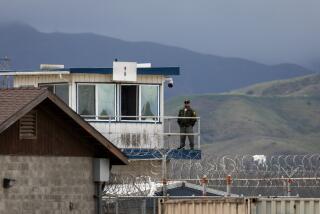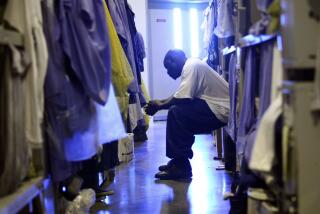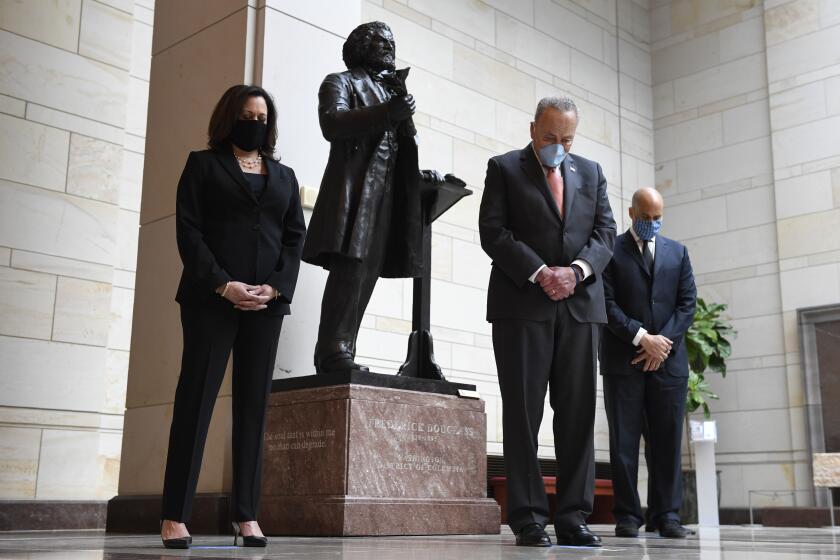Capitol Journal: California’s bail reform bill isn’t perfect, but half a loaf is better than none

When state legislators voted to end California’s unfair bail system for criminal defendants, they were following the wisdom of Otto von Bismarck.
They also were bowing to the demands of a modern sage, Gov. Jerry Brown.
Bismarck, a 19th century German chancellor, famously observed that “politics is the art of the possible.” That means it’s not about doing what’s best. It’s about doing what realistically can be done.
The bail bill that passed both legislative houses this week fell far short of achieving what some of its original advocates had wanted. They accused sponsors of a bait-and-switch and turned against the measure.
The defectors complained the final compromise could result in more defendants being jailed prior to trial than under the current bail system. They objected to judges being given more power to decide whether a defendant is jailed or freed. They predicted judges would be skittish about releasing defendants, fearful some Willie Horton might commit a heinous crime that would end their careers.
“If a judge locks someone up, that person is never going to commit a terrible crime that hurts the judge,” UC Berkeley law school dean Erwin Chemerinsky told me. “They’ll overprotect.
“And what we know about the criminal justice system,” he added, “is that whenever there is unlimited [judicial] discretion, it works to the disadvantage of racial minorities.”
But regardless of any flaws, the bill accomplished what had been the central goal of its backers. That was to junk the bail system. If more defendants are locked up, it won’t be because they’re poor and can’t raise bail.
“Currently we have a system that punishes people and takes away their liberty simply because they have less money. That’s not fair,” Sen. Bob Hertzberg (D-Van Nuys), the bill’s lead author, said in a statement after the compromise was reached.
The senator reminded me that Harvey Weinstein, accused of sexual assault, was able to write a $1-million check and remain free awaiting trial in New York. That’s a rich man’s perk.
“It’s perverse,” Hertzberg said.
Assemblyman Rob Bonta (D-Alameda), the main coauthor, put it this way: “The jailhouse door shouldn’t open and close based on how much money you have in your pocket.”
Under California’s long-held system, when someone is busted, a judge sets bail based on the crime’s severity and the accused’s perceived flight risk. The amount varies from county to county.
If the defendant doesn’t have enough cash to free himself, he can contact a bail agent who will post the money. But first, he typically must pay the agent 10% of the bail amount. That’s not refundable. And poor people usually don’t have that kind of cash.
Three years ago, the Public Policy Institute of California estimated that the median bail amount in this state was $50,000 — five times higher than the rest of the country. That meant $5,000 for a bail agent. A federal survey found that nearly half of Americans didn’t even have $400 for an emergency.
The institute reported that nearly two-thirds of inmates in crowded county jails were there awaiting trial, mostly because they couldn’t afford bail.
Brown began pitching for bail reform four decades ago during his first tenure as governor.
In his 1979 State of the State address, he called bail a “tax on poor people [who] languish in the jails of this state even though they have been convicted of no crime.” He urged the Legislature to overhaul the bail system and make it “as just and as fair as we can make it.”
The lawmakers essentially ignored him. Fast-forward 39 years, and current legislators didn’t just overhaul the bail system, they eliminated it.
Hertzberg and Bonta began pushing legislation to eliminate bail early last year. Brown’s chief of staff, Nancy McFadden, was enthusiastic. She actively tried to bring opposing sides together in a compromise.
But McFadden left the Capitol at year’s end to fight ovarian cancer. She died in March. That stalled the bail bill for months.
Coverage of California politics »
Ultimately Brown insisted on giving judges the power to jail or release defendants. Criteria will be set by county supervisors — the kind of local control Brown prefers.
Under the bill, a “risk analysis” will be made of each person arrested. Defendants will be sorted into low-, medium- or high-risk categories. Generally, low-risk defendants will be freed, and high-risk jailed. Those considered medium-risk will be at the judge’s mercy.
One reason Brown likes this solution is that it embodies recommendations of a judicial task force created by state Supreme Court Chief Justice Tani Cantil-Sakauye, an outspoken advocate of dumping the bail system.
Liberals complain that many judges are former prosecutors and contend that they can’t be trusted with criminal defendants. But they forget that this blue state probably will be governed by Democrats for the foreseeable future. Governors appoint state judges. And the California court system is likely to move left.
After lengthy, spirited floor debates, the bill narrowly passed the Assembly, 42 to 31, and the Senate, 26 to 12. Democrats generally voted for the measure and Republicans against.
“It’s a crappy bill and it’s going to need a lot of fixes,” Assemblyman Al Muratsuchi (D-Torrance) told his colleagues. “But I’m afraid that if we don’t vote on this bill now, it’s not going to pass.”
That’s not as eloquent as Bismarck, but it’s the same idea.
Follow @LATimesSkelton on Twitter
More to Read
Get the L.A. Times Politics newsletter
Deeply reported insights into legislation, politics and policy from Sacramento, Washington and beyond. In your inbox three times per week.
You may occasionally receive promotional content from the Los Angeles Times.











